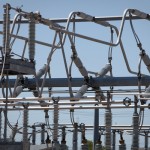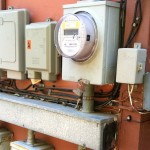Higher Prices for Texas Electricity: What A New Report Recommends

Dave Fehling/StateImpact Texas
There is disagreement over whether higher wholesale prices could raises costs for residential customers
With warnings piling up that Texas could face power blackouts this summer, a consulting group gave its support to the Texas Public Utility Commission’s (PUC) proposal to dramatically increase the cap on the wholesale price of electricity during critical, high demand times. The idea is to make Texas a more profitable electricity market so investors will be willing to fund construction of new power plants.
The Brattle Group report to the Electric Reliability Council of Texas (ERCOT) recommends tripling the maximum wholesale price “from the current $3,000 to $9000…but impose this price cap only in extreme scarcity events,” said the report.
Those figures are in keeping with what the PUC has proposed and which the commission’s chairman wants to start phasing in this summer.
But the Brattle Group report had a warning:
“…we urge caution about implementing major changes too quickly or without sufficient analytical support or stakeholder consideration. Complex market design changes will likely take more than a year to implement, and market participants need to be allowed ample time to prepare for the implementation of any changes.”

PUC of Texas
Donna Nelson is Chairman of the Texas PUC
PUC Chairman Donna Nelson said in a statement issued through ERCOT:
“The Brattle Group’s report confirms that we are moving in the right direction. I look forward to reviewing the report fully and discussing next steps with my fellow Commissioners in the coming months.”
Consumer groups, some municipal governments, and some environmental groups counter that higher prices are the last thing Texas needs, pointing out its electricity already costs more than in many of the surrounding states.
The Lone Star Chapter of the Sierra Club said the price cap proposals will hurt residential users:
“The proposal by PUC to raise the maximum bid from $3,000 up to $9,000 for one megawatt hour could put the squeeze on the average Texan’s wallet, costing a household an additional $480 a year in electricity cost. An independent analysis performed on behalf of ERCOT found that raising the maximum cost of one megawatt to $4,500 would raise overall electricity prices by some $15 per month on the average homeowner’s bill, while PUC’s second proposal to raise the maximum bid to $9,000 by 2015 could raise overall prices by $40 dollars on the average bill.”
In a conference call with reporters Friday afternoon, Sam Newell, Principal of The Brattle Group, downplayed the impact on consumers.
“Going to higher caps may sound like it would cost people a lot of money. (But) it does not necessarily cost people more money than having lower caps,” said Newell.
How could that be?
“If you have higher caps, you expect more investment. More investment means you get into scarcity conditions less often. So you’ll get higher prices less often. If you have a lower cap, you’ll have a little less capacity built and so you’ll run into scarcity conditions and high prices more often,” said Newell.
Newell said the benefit to a higher price and more generating capacity is more reliability; that is, less risk of shortages during high demand, hot days.
But will the higher price cap really spur construction of new power plants? Or are investors skittish after power projects in Texas and elsewhere ran into trouble a decade ago?
“In general, I would say the investors were overzealous then, now they’re just being smart,” said Newell.
“If the market signals are right, plenty will come and build.”
Read the full report here.

